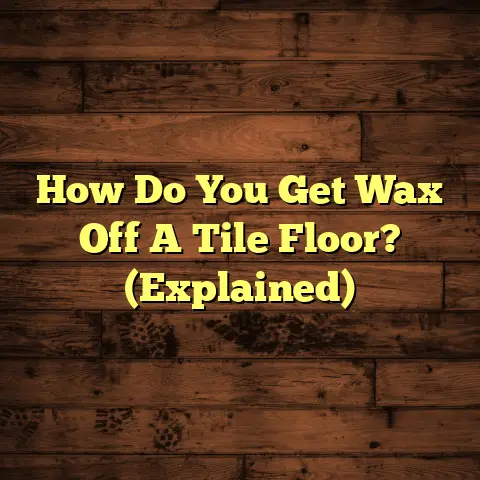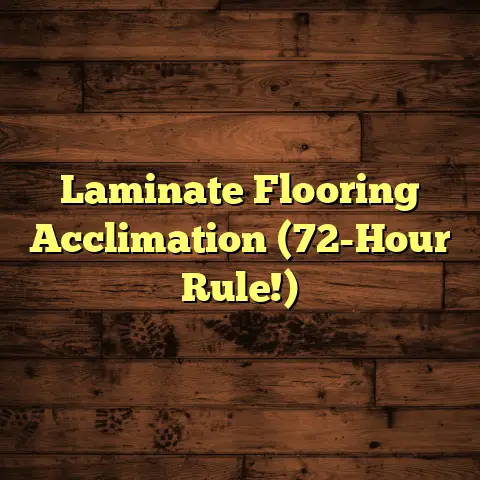Rug Pads On Laminate: Safe or Risky? (2 To Avoid!)
2 to Avoid!
Ever notice how sound just bounces around in rooms with laminate flooring?It’s like living in an echo chamber sometimes, right?
I’m here to tell you about rug pads, those unsung heroes of home comfort, and whether they’re a friend or foe to your laminate floors.
Think of rug pads as the silent guardians of your floors and ears.
They cushion your steps, keep your rugs from sliding, and, most importantly, they soak up sound.
A good rug pad can really transform a room, making it feel warmer, quieter, and more inviting.
But here’s the catch: Not all rug pads are created equal, especially when it comes to laminate.
Some can actually damage your floor, trapping moisture or leaving nasty residues.
So, are rug pads safe on laminate? The answer is a resounding “it depends!”
Let’s dive into the world of laminate and rug pads, so you can make the right choice for your home.
1. Understanding Laminate Flooring
So, what exactly is laminate flooring?
Imagine a high-tech sandwich.
Laminate is made up of several layers bonded together under high pressure.
- The Wear Layer: This is the top layer, a clear, durable coating that protects against scratches, stains, and fading.
- The Decorative Layer: This is where the magic happens – a high-resolution image of wood, stone, or tile that gives the laminate its realistic look.
- The Core Layer: Usually made of high-density fiberboard (HDF) or medium-density fiberboard (MDF), this layer provides stability and resistance to impact.
- The Backing Layer: This bottom layer provides moisture resistance and helps prevent warping.
I’ve seen laminate flooring mimic everything from rustic oak to sleek marble, and the quality keeps getting better.
Why is Laminate so Popular?
Well, for starters, it’s affordable. Compared to hardwood or tile, laminate won’t break the bank.
It’s also durable. That wear layer can take a beating from kids, pets, and everyday foot traffic.
And let’s not forget easy maintenance. A quick sweep or mop is usually all it takes to keep it looking its best.
The Downsides?
Like any flooring, laminate has its weaknesses.
- Scratching: While the wear layer is tough, it’s not indestructible. Sharp objects can still leave scratches.
- Moisture: Laminate isn’t waterproof. Spills need to be cleaned up quickly to prevent swelling and warping.
- Noise: This is where rug pads come in! Laminate can be noisy, especially in high-traffic areas.
Laminate vs. the Competition
Compared to hardwood, laminate is more scratch-resistant and less prone to water damage, but it doesn’t have the same warmth and natural beauty.
Tile is waterproof and incredibly durable, but it can be cold and hard underfoot.
Laminate offers a sweet spot: affordability, durability, and relatively easy care.
2. The Role of Rug Pads
Okay, we know laminate. Now, what’s the deal with rug pads?
A rug pad is that layer of material you place between your area rug and your floor.
They come in all shapes, sizes, and materials, each designed to serve a specific purpose.
Why Use a Rug Pad?
Let me count the ways:
- Comfort: Adds extra cushioning underfoot, making your rugs feel softer and more luxurious.
- Safety: Prevents rugs from slipping and sliding, reducing the risk of falls.
- Protection: Protects both your rug and your floor from wear and tear.
- Noise Reduction: Absorbs sound and reduces echo, creating a quieter, more peaceful environment.
- Aesthetics: Helps rugs lie flat and look their best, enhancing the overall appearance of your room.
I’ve seen rug pads extend the life of rugs by years, simply by preventing them from being crushed and worn down.
Types of Rug Pads
- Felt: Made from recycled fibers, felt pads are dense and provide excellent cushioning.
- Rubber: Offer superior grip and prevent rugs from slipping.
- Felt-Rubber Combo: A combination of felt and rubber, providing both cushioning and grip.
- Memory Foam: Provides exceptional comfort and support.
- PVC: A synthetic material that offers good grip but can sometimes leave residue on floors (more on this later!).
Each type has its pros and cons, and the best choice depends on your specific needs and flooring type.
3. Noise Reduction Benefits of Rug Pads on Laminate
Let’s talk about noise. Laminate floors, while beautiful, can be noisy.
Every step, every dropped object, every playful pet can create echoes and reverberations that fill the room.
That’s where rug pads come to the rescue!
How Rug Pads Reduce Noise
Rug pads act as a barrier between your rug and the hard surface of the laminate floor.
They absorb the impact of footsteps and other sounds, preventing them from traveling through the floor and creating noise.
Think of it like a shock absorber for sound waves.
The Science of Sound Absorption
Materials like felt and rubber are particularly good at absorbing sound because they have a dense, porous structure.
These materials trap sound waves and convert them into heat energy, reducing the amount of sound that bounces around the room.
I’ve seen homeowners drastically reduce noise levels in their homes simply by adding a quality rug pad under their area rugs.
Real-World Examples
I once worked with a client who lived in a multi-story condo.
Her downstairs neighbors were constantly complaining about the noise from her laminate floors.
After installing felt rug pads under her rugs, the complaints stopped.
She was amazed at the difference it made!
In apartments or multi-story homes, rug pads are essential for maintaining peace and quiet.
They can also be a lifesaver in rooms with high ceilings or hard surfaces, which tend to amplify sound.
4. Potential Risks of Using Rug Pads on Laminate Flooring
Okay, so rug pads can be great for noise reduction and comfort, but they’re not without their risks.
Using the wrong type of rug pad on laminate can actually cause damage.
Moisture Trapping
One of the biggest concerns is moisture.
Some rug pads, especially those made of solid rubber or PVC, can trap moisture between the rug and the laminate floor.
This can lead to warping, buckling, or even mold growth.
I’ve seen laminate floors ruined by moisture trapped under a rug pad.
It’s not a pretty sight, and it’s an expensive fix.
Residue and Staining
Certain rug pads, particularly those made of PVC or low-quality rubber, can leave residues or stains on laminate floors.
These residues can be difficult to remove and can permanently damage the finish of your floor.
I once had to help a client remove a sticky, discolored residue left by a cheap PVC rug pad.
It took hours of scrubbing and special cleaning solutions.
Slipping Hazards
Ironically, some rug pads can actually increase the risk of slipping.
If the pad doesn’t have enough grip or if it’s not properly sized for the rug, it can slide around on the floor, creating a tripping hazard.
I’ve seen this happen with thin, flimsy rug pads that don’t provide adequate traction.
Choosing Wisely
The key to avoiding these problems is to choose the right rug pad for your laminate flooring.
Look for breathable materials that won’t trap moisture and avoid those that are known to leave residues.
5. Two Types of Rug Pads to Avoid
Alright, let’s get down to specifics. Here are two types of rug pads that I generally advise against using on laminate flooring:
Type 1: Solid Rubber Rug Pads
Solid rubber pads are often marketed as providing superior grip, and they do!
However, their non-porous nature is a major drawback for laminate.
Why They’re Bad for Laminate:
- Moisture Trap: Solid rubber doesn’t breathe. Any moisture that gets trapped underneath (from spills, humidity, or even just condensation) has nowhere to go. This can lead to warping and damage to your laminate.
- Residue: Some solid rubber pads can break down over time, leaving a sticky residue on your floor.
- Lack of Cushion: While they offer grip, solid rubber pads often lack cushioning, which defeats one of the main purposes of using a rug pad.
Case Study:
I had a client who used a solid rubber pad under a large area rug in her living room.
She noticed a musty smell after a few months and discovered that the laminate under the rug was warped and discolored.
The culprit? Trapped moisture. The cost to repair the damage was significant.
Type 2: PVC Rug Pads
PVC (polyvinyl chloride) rug pads are another common type, often found at lower price points.
While they offer some grip, they come with several potential problems.
Why They’re Bad for Laminate:
- Chemical Off-Gassing: PVC can release harmful chemicals into the air, especially when new.
- Residue: PVC can break down over time, leaving a sticky, oily residue on your laminate floor. This residue can be difficult to remove and can damage the finish.
- Lack of Cushion: Like solid rubber, PVC pads often lack adequate cushioning.
- Environmental Concerns: PVC is not an environmentally friendly material.
Anecdote:
I remember a client who used a PVC rug pad under a rug in her entryway.
After a year, she noticed a discolored patch on her laminate floor where the rug pad had been.
The PVC had reacted with the finish of the laminate, causing permanent staining.
Better Alternatives
So, what should you use instead?
- Felt Pads: Provide excellent cushioning and are breathable.
- Felt-Rubber Combo Pads: Offer a good balance of cushioning and grip.
- Natural Rubber Pads: Made from natural rubber, these pads are more eco-friendly and less likely to leave residue.
Conclusion
Choosing the right rug pad for your laminate flooring is crucial for protecting your investment and enjoying a comfortable, quiet home.
While rug pads can be incredibly beneficial for noise reduction, comfort, and safety, it’s important to be aware of the potential risks.
Avoid solid rubber and PVC rug pads, as they can trap moisture, leave residues, and damage your laminate floor.
Instead, opt for breathable materials like felt, felt-rubber combos, or natural rubber.
By making informed choices, you can enjoy the benefits of rug pads without compromising the beauty and longevity of your laminate flooring.
Happy decorating!





